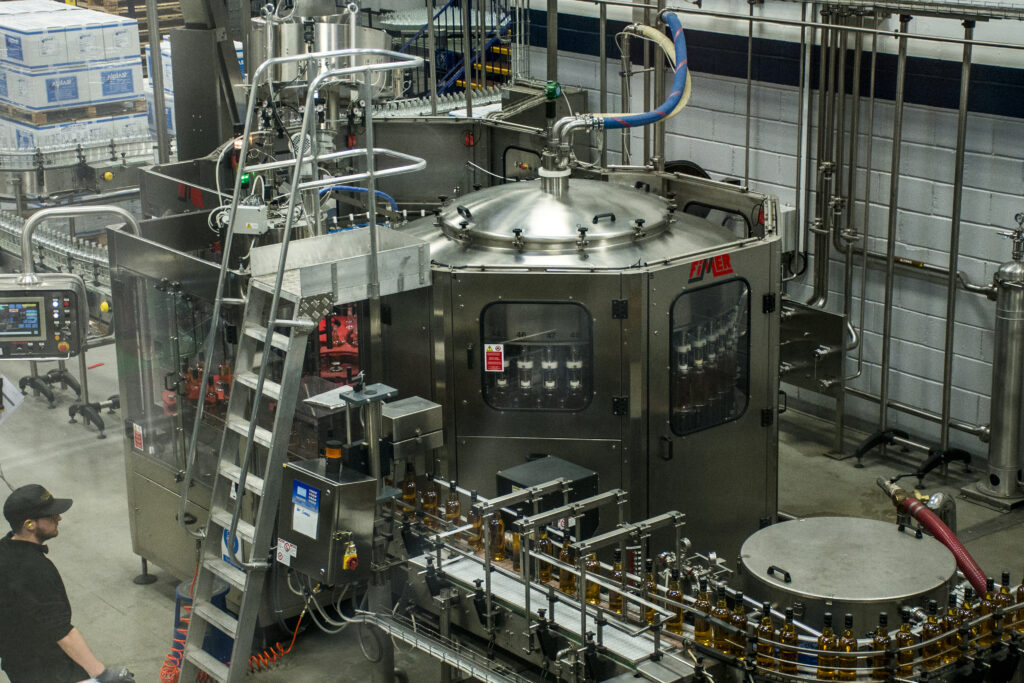
By: Becky Garrison
December 5, 1933, marks the date the repeal of the 18th Amendment went into effect, thus ending the United States’ failed efforts to outlaw liquor. The 18th Amendment to the United States Constitution, which went into effect on January 17, 1920, prohibited the manufacture, sale and transportation of alcoholic beverages and their import into or export from the United States and all its territories. The National Prohibition Act designed to enforce this amendment became known as the Volstead Act after Rep. Andrew J. Volstead (R-MN).
Despite this ban, alcohol continued to flow throughout the United States. So, what exactly were people drinking during Prohibition?
Legal Consumption of Alcohol During Prohibition
Select exemptions under the Volstead Act permitted one to imbibe legally. Any liquor purchased before January 17, 1920, could be consumed at home. Private social clubs and individuals of means and available space amassed a collection of fine wines and liquors that would rival any well-stocked bar, with liquor stores announcing “going out of business” sales throughout the country.
In keeping with the spirit of allowing mild alcohol consumption in private, this act permitted home winemaking and brewing. Soon after National Prohibition began in the 1920s, grocery stores often carried brick-sized blocks called “Vine-Glo.” These compressed raisins were bound together with condensed grape juice. Attached to the block was a small container of dried yeast. The wrapping contained the following text:
“WARNING: Do not dissolve this fruit brick in warm water and then add the contents of the yeast packet, as this will result in fermentation and the creation of alcohol, the production of which is illegal.”
Along those lines, this act banned only the sale of beer but not the ingredients for making it. So, one could purchase malt syrup with a packet of yeast attached that included similar instructions that combining the two could result in an illegal product.
Also, one could obtain liquor with a medical prescription from a licensed doctor. However, in the first five years of Prohibition, only 26 states allowed the sale of medicinal liquor. In addition, liquor could be used for sacramental and religious purposes, though no statistics exist regarding how many Americans suddenly “got religion” during Prohibition.
The Canadian Connection
Under Canadian law, local distillers could make spirits for sale to the United States if they paid a $20 per gallon export tax. By the late 1920, the Canadian government suddenly realized how much alcohol revenue was being earned by these various export houses, courtesy of the American bootleggers, and decided to raise the annual licensing fees for these liquor exporting businesses from $3,000 to $10,000.
As expected, the U.S. government pressured Canada to stem the flow of liquor coming from Canada to the United States. In 1930, the Canadian government finally passed a law banning foreign customers from purchasing booze directly from export houses. However, this failed to deter the export of spirits coming primarily from British Columbia, Ontario and Toronto.
Other international waters where one could find smuggling of illicit spirits included the Caribbean, where rum was smuggled, especially along the East Coast. Those who transported their wares via sea, often using high-speed boats designed to evade capture, became known as rumrunners, named after the spirit they were transporting.
Distilling Prohibition-Era Spirits
Since law enforcement could spot the trails of smoke coming from fires used to heat illegal stills, moonshiners often used cane or malt syrup, as these products could be fermented at room temperature, unlike raw grains that needed to be cooked pre-fermentation. Traditionally, distillers make “cuts” (discarding the beginning and end of the run) of the liquid out of the still to ensure they remove the natural acetaldehyde, methanol and fusel oils that form during fermentation. During Prohibition, distillers often skipped that step so they could get more product from each run, resulting in illegal hooch that proved to be deadly at times.
This cutting tended to take place at night in seemingly deserted industrial-looking buildings, rural farms, and other facilities that wouldn’t draw undue attention from law enforcement. Some added water to their liquor so they could produce more bottles from each run. Then, they turned to industrial (denatured) alcohol to give the product an extra kick now that it had been diluted. Denatured alcohol product was still on the market as it was used to make products like fuel, explosives and solvents. Among the products used for cutting were mouthwash, hair tonic, shellac and perfume. Even after the government added an emetic to those products containing denatured alcohol, they were still used as cutting agents with cocktails designed to mask the vile taste of these Prohibition-era spirits.
In The Spirits of America, Eric Burns notes how poisoned booze was the great, unsung tragedy of Prohibition. “People today know about bootleggers and speakeasies; they are familiar with the names Capone and Kennedy; they have a general impression of casual lawbreaking and wild times kindled by spirits that were not supposed to be so readily available. But they do not know about Yack Yack Bourbon and Jackass Brandy and Squirrel Whiskey. They do not know about cooking alcohol squeezed through a rag and mothballs dropped into a steaming mug of gasoline. And they do not know about Jamaica gin and the men who drank it in doses that were so much more than minute, thereby getting rid of their thirsts for a few minutes as they turned into cripples for the rest of their lives.” (Page 224)
As Daniel Okrent noted in Last Call: The Rise and Fall of Prohibition, “In the saloon era, calling for liquor by brand name was almost unheard of; in the speakeasy era, it became a habit, first as a means of protecting oneself from alcohol of questionable origin, and secondarily as a way of expressing one’s level of taste. Decades later, many of the liquor industry’s best-known brand names owed their prominence to the ubiquity of Prohibition-era rotgut. But knowing one’s brand did not ensure one was drinking said brand. In too many places, if you ordered Brand X, you got Brand X; if you ordered Dewar’s or Gordon’s, you paid twice as much and got Brand X.” (page 162)
The Repeal of Prohibition
While some states began loosening their liquor laws in the early 1930s, National Prohibition was still in effect until December 5, 1933, when Utah was the 36th state to vote for the 21st amendment repealing Prohibition. The debate over alcohol shifted from whether Prohibition should be repealed to debates over how to tax and regulate the sale of alcohol and distilled spirits in particular.
John D. Rockefeller, Jr., a nondrinking Baptist who had earlier been a heavy donor to the antiliquor cause, funded a study group in 1933 to explore how to best address this “alcohol problem.” While the group recommended that Prohibition be repealed, they advocated for strict government control of alcohol sales, preferably through state stores where the states could make profits.
In response, the federal government adopted a three-tier system that permitted each state to develop a structure of checks and balances that provided safe alcohol to consumers while ensuring a simple method to collect tax revenue. The three-tier system is simple in theory: manufacturers provide alcoholic products to wholesalers, who distribute the products to retailers, who sell to the consumers. No one entity can be involved in more than one tier under most state models, and each tier is regulated and licensed separately.
Alexandra Clough, a spokesperson for the American Crafts Spirits Association (ACSA), reflects on the lingering effects of Prohibition 90 years after its repeal. “We have made much progress to help consumers gain access to craft spirits, but we still struggle to achieve the same loosened regulations that our counterparts in beer and wine have enjoyed for many years. Though we, of course, will be toasting the 90th anniversary of Repeal Day, we will also continue to focus on helping consumers access the incredible craft spirits this country has to offer in more modern ways, like through direct shipping.”
In recent years, distillers ranging from craft nano-distilleries to Jack Daniels have come out with their version of “White Whiskey,” A.K.A. moonshine. In 2023, Buffalo Trace launched The Prohibition Collection, an annual limited-edition, multi-bottle collection they describe as “honoring the whiskeys that were legally produced and sold at the distillery during arguably the most contentious period in alcohol history.” This debut release tributes five Prohibition-era brands: Old Stagg, Golden Wedding, Three Feathers, Walnut Hill and George T. Stagg Spiritus Frumenti.
Spirits like Wohlfert Craft’s Distilling’s Sugar Shine continue their family’s spirited legacy by distilling spirits using their relatives’ recipes. John Wolfert’s great-grandparents opened several successful “bakeries,” which became a more spirited clandestine operation during Prohibition. As the smell of the yeast and sugar fermenting smelled similar to bread, they were able to ferment their brews undetected and were even able to downplay a still explosion as simply the result of, say, a gas leak.
Even though December 5 has yet to achieve the notoriety of, say, St. Patrick’s Day, some bartenders from across the country continue to honor Prohibition Repeal Day by highlighting Prohibition-era cocktails, including the Bee’s Knees, Side Car and Gin Rickey. Buildings like Smith Tower, where Seattle’s gentleman bootlegger Roy Olmstead conducted his smuggling operations, celebrate the Roaring Twenties with historical displays and craft cocktails on their 35th-floor Observatory Bar. Other establishments, such as Bar 600, located inside Cannery Pier Hotel & Spa in Astoria, Oregon, continue the spirit of this era. Situated on the former site of the Union Fisherman’s Cooperative Packing Company, this decor takes one back to an earlier era by recreating the feeling of the canneries of yesteryear with smokestacks, exposed steel beams & wooden trusses along with a vintage car service.
Portions of this article are excerpted in Distilled in Washington: A History (March 18, 2024).










